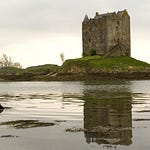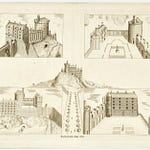Welcome back to "A Scottish Castle, A Day," brought to you by bagtownclans.com. I’m your host, Colin MacDonald, and today, we’re sailing out into the misty waters of Loch Leven to explore one of Scotland’s most historically charged locations—Loch Leven Castle. This 14th-century island fortress, set against the stunning backdrop of Perth and Kinross, is steeped in stories of military action, rebellion, and the dramatic imprisonment and escape of one of Scotland’s most iconic figures, Mary, Queen of Scots.
Loch Leven Castle is perhaps most famously known as the place where Mary, Queen of Scots, was held prisoner for nearly a year, but the history of this island fortress goes back much further. Its name, according to legend, may come from the eleven rivers that flow into the loch, though today the waters are lower than in medieval times, when they nearly lapped at the castle’s walls.
The first mentions of a stronghold on this island date back to the 1290s, during the Wars of Scottish Independence. At that time, the castle was under English control, one of many fortifications established by King Edward I during his brutal campaign to subdue Scotland. It was likely a wooden structure at first, and it didn’t take long before it attracted the attention of the Scottish resistance. In a daring raid, none other than William Wallace stormed the castle under the cover of night, slaying the English garrison and reclaiming the stronghold for Scotland.
In 1313, Robert the Bruce himself visited the castle, and not long after, it began its long history as a state prison. One of its earliest inmates was John of Lorn, a rebel captured by Bruce in 1316, who spent his days contemplating his fate within the castle’s thick stone walls. Loch Leven Castle would go on to be a key player in Scotland’s power struggles over the next several centuries, changing hands and withstanding sieges during the tumultuous years of both the First and Second Wars of Independence.
The English laid siege to Loch Leven Castle in 1335, during yet another attempt to claim Scotland’s crown. According to legend, the attackers tried a creative, if ultimately disastrous, strategy: they built a dam across the outflow of the loch in an effort to flood the castle. While the water level did rise, the defenders managed to sabotage the dam one night, releasing a torrent of water that not only saved the castle but also flooded the English camp. It’s a story straight out of a medieval epic, though some historians have cast doubt on its accuracy.
By the mid-14th century, the castle was reinforced with the addition of a stone tower house, making it one of the oldest surviving examples of this type of medieval fortification in Scotland. This tower still stands today, its five-storey shell looming over the island, a silent witness to the many historical figures who once called this castle home—or prison.
One of the most famous of those prisoners was, of course, Mary, Queen of Scots. Following her defeat at the Battle of Carberry Hill in 1567, she was taken to Loch Leven Castle, where she was held by Sir William Douglas of Lochleven. For almost a year, Mary lived in Glassin Tower, the round tower in the southeastern corner of the castle, under constant guard. The conditions were far from luxurious, with only a handful of her loyal servants permitted to stay with her, including her ladies-in-waiting.
It was during her imprisonment here that Mary suffered some of her greatest personal losses. She fell gravely ill and miscarried twins she had conceived with her third husband, the Earl of Bothwell. The grief was immense, and it was during this time that she was forced to abdicate the throne in favor of her infant son, James VI.
But Mary’s time at Loch Leven is perhaps most famous for her daring escape. With the help of young William Douglas, a member of the very family holding her prisoner, she managed to slip out of the castle on the night of May 2, 1568. Disguised as a servant, she crept through the castle, with Douglas stealing the keys to the gates and rowing her across the loch to the mainland. From there, she rallied her supporters, though her attempt to reclaim her throne ended in failure at the Battle of Langside just days later.
In the years that followed Mary’s dramatic escape, Loch Leven Castle passed into the hands of Sir William Douglas’s descendants. It remained with the Douglases for the next 300 years, though it gradually lost its importance as a residence. In 1672, the castle was sold to Sir William Bruce, the royal architect responsible for redesigning Holyrood Palace. He had grand plans for the estate, building the elegant Kinross House on the loch’s shore, with the castle serving as a picturesque feature in the landscape. But as Kinross House became the focus of the estate, Loch Leven Castle was abandoned, left to crumble into ruin.
Today, Loch Leven Castle is a haunting ruin, but one that still holds the power to stir the imagination. The curtain walls and tower house remain, standing proud on the island that has borne witness to centuries of Scotland’s tumultuous history. Visitors can reach the island by ferry during the summer months, walking in the footsteps of William Wallace, Robert the Bruce, and Mary, Queen of Scots.
The castle may no longer house lords or queens, but its stones echo with the stories of the past. Loch Leven Castle serves as a reminder of the fierce battles for Scotland’s independence, the power struggles of its nobles, and the tragic, yet resilient spirit of Mary, Queen of Scots.
Thank you for joining me on this episode of "A Scottish Castle, A Day." I hope you’ve enjoyed uncovering the rich history of Loch Leven Castle. Be sure to tune in tomorrow as we continue our journey through Scotland’s remarkable castles. I’m Colin MacDonald, and until next time, Slán go fóill!













Share this post